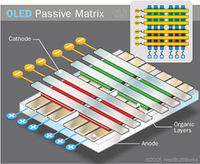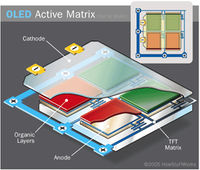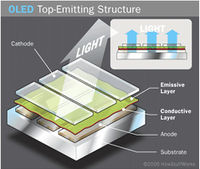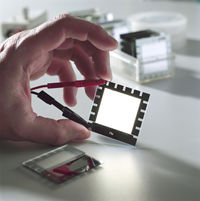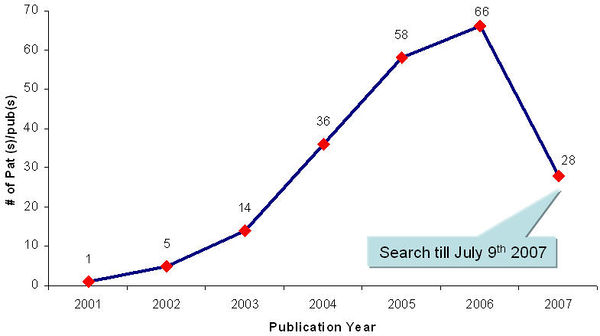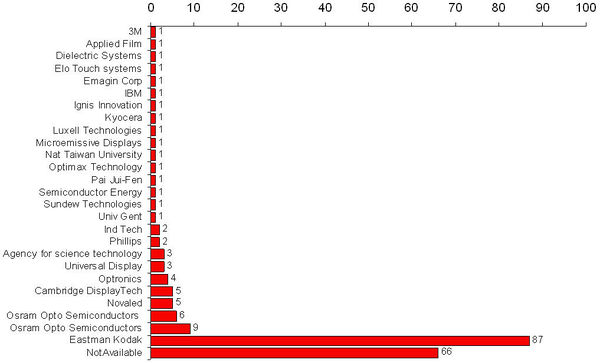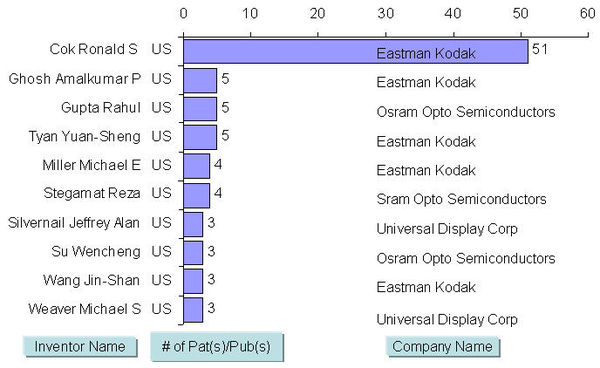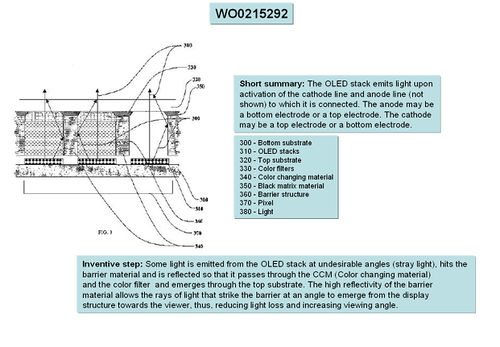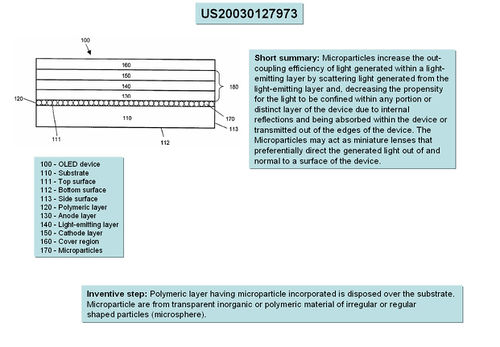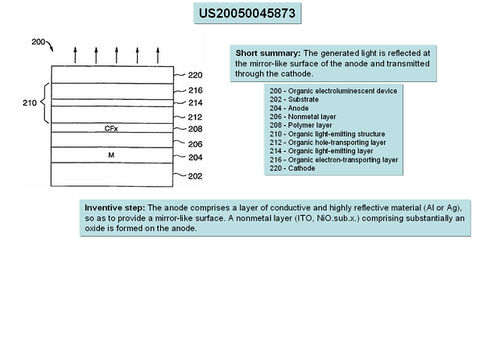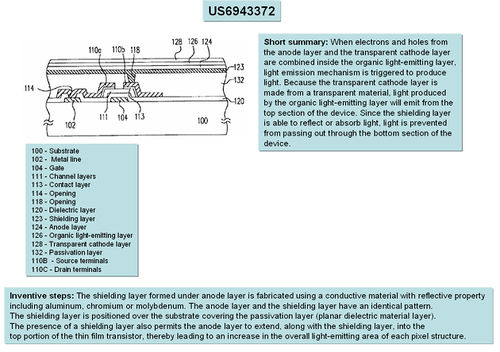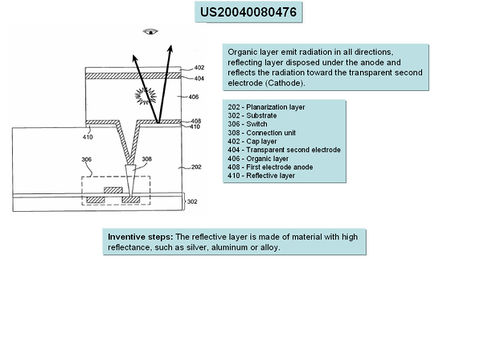OLED - Organic Light Emitting Diode
Contents
[hide]Introduction
The growing number of electronic devices using organic light emitting diode displays shows that after years of promise, the technology is finding a home in more and more products. But while OLED displays might challenge LCDs as the screens of choice for smaller gadgets, the technology is not expected to become mainstream for notebook PCs or TVs within this decade.
OLED displays use organic compounds that emit light when exposed to an electric current. They are brighter, have better contrast, offer wider viewing angles, use less power, and provide faster response times than liquid crystal displays. OLED screens can also be one-third thinner than LCDs, since they don't need a backlight, and that makes them a good fit for portable electronics devices.
OLED Types
There are several types of OLEDs
- Passive-matrix OLED
- Active-matrix OLED
- Transparent OLED
- Top-emitting OLED
- Bottom-emitting OLED
- Foldable OLED
- White OLED
Passive-matrix OLED - PMOLED
PMOLEDs have strips of cathode, organic layers and strips of anode. The anode strips are arranged perpendicular to the cathode strips. The intersections of the cathode and anode make up the pixels where light is emitted. External circuitry applies current to selected strips of anode and cathode, determining which pixels get turned on and which pixels remain off. Again, the brightness of each pixel is proportional to the amount of applied current.
PMOLEDs are easy to make, but they consume more power than other types of OLED, mainly due to the power needed for the external circuitry. PMOLEDs are most efficient for text and icons and are best suited for small screens (2- to 3-inch diagonal) such as those you find in cell phones, PDAs and MP3 players. Even with the external circuitry, passive-matrix OLEDs consume less battery power than the LCDs that are currently used in these devices.
Active-matrix OLED - AMOLED
AMOLEDs have full layers of cathode, organic molecules and anode, but the anode layer overlays a thin film transistor (TFT) array that forms a matrix. The TFT array itself is the circuitry that determines which pixels get turned on to form an image.
AMOLEDs consume less power than PMOLEDs because the TFT array requires less power than external circuitry, so they are efficient for large displays. AMOLEDs also have faster refresh rates suitable for video. The best uses for AMOLEDs are computer monitors, large screen TVs and electronic signs or billboards.
Transparent OLED
Transparent OLEDs have only transparent components (substrate, cathode and anode) and, when turned off, are up to 85 percent as transparent as their substrate. When a transparent OLED display is turned on, it allows light to pass in both directions. A transparent OLED display can be either active- or passive-matrix. This technology can be used for heads-up displays.
Top-emitting OLED
Top-emitting OLEDs have a substrate that is either opaque or reflective. They are best suited to active-matrix design. Manufacturers may use top-emitting OLED displays in smart cards.
Foldable OLED
Foldable OLEDs have substrates made of very flexible metallic foils or plastics. Foldable OLEDs are very lightweight and durable. Their use in devices such as cell phones and PDAs can reduce breakage, a major cause for return or repair. Potentially, foldable OLED displays can be sewn into fabrics for "smart" clothing, such as outdoor survival clothing with an integrated computer chip, cell phone, GPS receiver and OLED display sewn into it.
White OLED
A white organic LED (OLED) incorporating a blue phosphorescent dye and a down-conversion phosphor has achieved a luminous efficacy of 25 lm/W. This high-efficacy device was enabled by lowering the device operating voltage, increasing the outcoupling efficiency, and incorporating highly efficient phosphorescent emitters.
Landscape Analysis Of Top-Emmission OLED
IP Landscape
Competitor Landscape
Competitor Mapping
| # | Assignee Name | 2001 | 2002 | 2003 | 2004 | 2005 | 2006 | 2007 | Total |
| 1 | Eastman Kodak | 1 | 3 | 23 | 24 | 24 | 12 | 87 | |
| 2 | Not Available | 3 | 10 | 9 | 20 | 18 | 6 | 66 | |
| 3 | Osram Opto Semiconductors | 2 | 1 | 4 | 2 | 9 | |||
| 4 | Osram Opto Semiconductors | 1 | 2 | 3 | 6 | ||||
| 5 | Cambridge DisplayTech | 1 | 4 | 5 | |||||
| 6 | Novaled | 1 | 2 | 2 | 5 | ||||
| 7 | Optronics | 4 | 4 | ||||||
| 8 | Agency for science technology | 2 | 1 | 3 | |||||
| 9 | Universal Display | 1 | 2 | 3 | |||||
| 10 | Ind Tech | 2 | 2 | ||||||
| 11 | Phillips | 1 | 1 | 2 | |||||
| 12 | 3M | 1 | 1 | ||||||
| 13 | Applied Film | 1 | 1 | ||||||
| 14 | Dielectric Systems | 1 | 1 | ||||||
| 15 | Elo Touch systems | 1 | 1 | ||||||
| 16 | Emagin Corp | 1 | 1 | ||||||
| 17 | IBM | 1 | 1 | ||||||
| 18 | Ignis Innovation | 1 | 1 | ||||||
| 19 | Kyocera | 1 | 1 | ||||||
| 20 | Luxell Technologies | 1 | 1 | ||||||
| 21 | Microemissive Displays | 1 | 1 | ||||||
| 22 | Nat Taiwan University | 1 | 1 | ||||||
| 23 | Optimax Technology | 1 | 1 | ||||||
| 24 | Pai Jui-Fen | 1 | 1 | ||||||
| 25 | Semiconductor Energy | 1 | 1 | ||||||
| 26 | Sundew Technologies | 1 | 1 | ||||||
| 27 | Univ Gent | 1 | 1 | ||||||
| 28 | Total | 1 | 5 | 14 | 36 | 58 | 66 | 28 | 208 |
Key Inventors
Key Inventor Mapping
| S.No | Top 10 Assignees of Last 5 Years | 2001 | 2002 | 2003 | 2004 | 2005 | 2006 | 2007 | Total |
| 1 | Cok Ronald S US | 2 | 12 | 13 | 13 | 11 | 51 | ||
| 2 | Ghosh Amalkumar P US | 1 | 2 | 2 | 5 | ||||
| 3 | Gupta Rahul US | 5 | 5 | ||||||
| 4 | Tyan Yuan-Sheng US | 1 | 3 | 1 | 5 | ||||
| 5 | Miller Michael E US | 1 | 1 | 2 | 4 | ||||
| 6 | Stegamat Reza US | 2 | 1 | 1 | 4 | ||||
| 7 | Silvernail Jeffrey Alan US | 2 | 1 | 3 | |||||
| 8 | Su Wencheng US | 1 | 2 | 3 | |||||
| 9 | Wang Jin-Shan US | 3 | 3 | ||||||
| 10 | Weaver Michael S US | 1 | 2 | 3 | |||||
| Total | 5 | 19 | 26 | 23 | 13 | 86 |
Technology Mapping
- In OLED devices not all internally generated light is coupled out of the device (only 20%-50%), which reduces the device efficiency and lifetime. Interesting trend in structures applied to improve outcouple efficiency in order to enhance the efficiency and Lifetime of top emission OLEDs are depicted.
